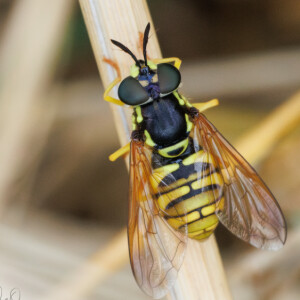Flow state
We've been going through some stuff here recently, and I've been a bit down, but I got a real boost when my son told me that he's started taking a quick look at my blog while doing his business admin of a morning. (If you're reading this, H: hello and welcome!) During this conversation I explained that being out and about in the natural world, observing wildlife and trying to photograph it, is a mindful activity for me, and he introduced me to the concept of the flow state, which perfectly describes my state of mind when I'm rummaging around a meadow after insects, or standing on the freezing Cotswold scarp photographing owls.
I was definitely 'in the zone' at Tilly's field this afternoon, and I had a good session, tracking down a particular hoverfly that's been eluding me all month, and finding several good hoppers of different species, including a leafhopper I'd never seen before. My Invert of the Day though is this male Meadow Grasshopper (Pseudochorthippus parallelus), because I like his colouring, and the way he tones with the background (Farrow and Ball: Dry Grassland). This shade of green is quite common in Meadow Grasshoppers (Farrow and Ball: Pseudochorthippus), but the brown 'points' are often confined to the hind knees, and it's the fact that his antennae and lower legs are also dark that makes this specimen particularly striking.
Identification points for this species: the pronotal keel - that is, the line that runs front to back along the side of the shoulder plate, behind the head - is slightly curved, flaring outwards from front to back. Why the species identifier is 'parallelus' when the keels aren't parallel is something that has always irked me, but it does at least act as a mnemonic. The wings are short, not reaching the hind knees, though they're longer than the obviously vestigial wings of females of this species; male and female are both flightless. The radial wing cells - the third row up from the bottom of the wing here - widen gradually, whereas in the similar Lesser Marsh Grasshopper they widen abruptly; this is useful when you can see it, but in the field the wings are often obscured by the hind legs. Some people also say that only the Meadow Grasshopper has dark hind knees, though I don't think that's a reliable feature, and I always feel that the face of a Meadow Grasshopper is more convex than that of a Lesser Marsh - but that's probably not reliable either.
My second photo today is the hoverfly I finally managed to capture properly on camera. As I'd suspected, she's Chrysotoxum verralli, one of the 'difficult five' Chrysotoxum species, and relatively rare outside the south east of England, but a species I recorded here once before, about three years ago. There's more about this hoverfly here.
Finally, I've posted my best leafhopper of the day on Facebook, if you'd like to see it.
R: C4, D10.


Comments
Sign in or get an account to comment.


